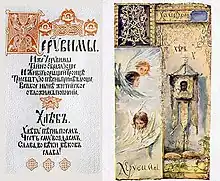Kha (Cyrillic)
Kha or Ha (Х х; italics: Х х) is a letter of the Cyrillic script. It looks the same as the Latin letter X (X x X x), in both uppercase and lowercase, both roman and italic forms, and was derived from the Greek letter Chi, which also bears a resemblance to both the Latin X and Kha.
| Cyrillic letter Kha | |||||||||||||||||||||||||||||||||||||||||||||||||||||||||||||||||||||||||||||||||||||||||||||||||||||||||||||||||||||||||||||||||||||||||||||||||||||||||||||||||||||||||||||||||||||||||||||||||||||||||||||||||
|---|---|---|---|---|---|---|---|---|---|---|---|---|---|---|---|---|---|---|---|---|---|---|---|---|---|---|---|---|---|---|---|---|---|---|---|---|---|---|---|---|---|---|---|---|---|---|---|---|---|---|---|---|---|---|---|---|---|---|---|---|---|---|---|---|---|---|---|---|---|---|---|---|---|---|---|---|---|---|---|---|---|---|---|---|---|---|---|---|---|---|---|---|---|---|---|---|---|---|---|---|---|---|---|---|---|---|---|---|---|---|---|---|---|---|---|---|---|---|---|---|---|---|---|---|---|---|---|---|---|---|---|---|---|---|---|---|---|---|---|---|---|---|---|---|---|---|---|---|---|---|---|---|---|---|---|---|---|---|---|---|---|---|---|---|---|---|---|---|---|---|---|---|---|---|---|---|---|---|---|---|---|---|---|---|---|---|---|---|---|---|---|---|---|---|---|---|---|---|---|---|---|---|---|---|---|---|---|---|---|
 | |||||||||||||||||||||||||||||||||||||||||||||||||||||||||||||||||||||||||||||||||||||||||||||||||||||||||||||||||||||||||||||||||||||||||||||||||||||||||||||||||||||||||||||||||||||||||||||||||||||||||||||||||
| Phonetic usage: | [x], [χ] [h] | ||||||||||||||||||||||||||||||||||||||||||||||||||||||||||||||||||||||||||||||||||||||||||||||||||||||||||||||||||||||||||||||||||||||||||||||||||||||||||||||||||||||||||||||||||||||||||||||||||||||||||||||||
| Name: | хѣръ | ||||||||||||||||||||||||||||||||||||||||||||||||||||||||||||||||||||||||||||||||||||||||||||||||||||||||||||||||||||||||||||||||||||||||||||||||||||||||||||||||||||||||||||||||||||||||||||||||||||||||||||||||
| Numeric value: | 600 | ||||||||||||||||||||||||||||||||||||||||||||||||||||||||||||||||||||||||||||||||||||||||||||||||||||||||||||||||||||||||||||||||||||||||||||||||||||||||||||||||||||||||||||||||||||||||||||||||||||||||||||||||
| Derived from: | Greek letter Chi (Χ χ) | ||||||||||||||||||||||||||||||||||||||||||||||||||||||||||||||||||||||||||||||||||||||||||||||||||||||||||||||||||||||||||||||||||||||||||||||||||||||||||||||||||||||||||||||||||||||||||||||||||||||||||||||||
| The Cyrillic script | |||||||||||||||||||||||||||||||||||||||||||||||||||||||||||||||||||||||||||||||||||||||||||||||||||||||||||||||||||||||||||||||||||||||||||||||||||||||||||||||||||||||||||||||||||||||||||||||||||||||||||||||||
| Slavic letters | |||||||||||||||||||||||||||||||||||||||||||||||||||||||||||||||||||||||||||||||||||||||||||||||||||||||||||||||||||||||||||||||||||||||||||||||||||||||||||||||||||||||||||||||||||||||||||||||||||||||||||||||||
| |||||||||||||||||||||||||||||||||||||||||||||||||||||||||||||||||||||||||||||||||||||||||||||||||||||||||||||||||||||||||||||||||||||||||||||||||||||||||||||||||||||||||||||||||||||||||||||||||||||||||||||||||
| Non-Slavic letters | |||||||||||||||||||||||||||||||||||||||||||||||||||||||||||||||||||||||||||||||||||||||||||||||||||||||||||||||||||||||||||||||||||||||||||||||||||||||||||||||||||||||||||||||||||||||||||||||||||||||||||||||||
| |||||||||||||||||||||||||||||||||||||||||||||||||||||||||||||||||||||||||||||||||||||||||||||||||||||||||||||||||||||||||||||||||||||||||||||||||||||||||||||||||||||||||||||||||||||||||||||||||||||||||||||||||
| Archaic or unused letters | |||||||||||||||||||||||||||||||||||||||||||||||||||||||||||||||||||||||||||||||||||||||||||||||||||||||||||||||||||||||||||||||||||||||||||||||||||||||||||||||||||||||||||||||||||||||||||||||||||||||||||||||||
| |||||||||||||||||||||||||||||||||||||||||||||||||||||||||||||||||||||||||||||||||||||||||||||||||||||||||||||||||||||||||||||||||||||||||||||||||||||||||||||||||||||||||||||||||||||||||||||||||||||||||||||||||

It commonly represents the voiceless velar fricative /x/, similar to how some Scottish speakers pronounce the ⟨ch⟩ in “loch”.
Kha is romanised as ⟨kh⟩ for Russian, Ukrainian, Mongolian, and Tajik, and as ⟨ch⟩ for Belarusian, while being romanised as ⟨h⟩ for Serbo-Croatian, Bulgarian, Macedonian, and Kazakh. It is also romanised as ⟨j⟩ for Spanish. The letter can have different pronunciations due to different Cyrillic languages so it may sometimes sound like the Digraph Kh as in Khalil or it can even sometimes sound like the Latin letter H as in hat. It mostly translates to Kh or H at most times, but sometimes it can also be translated to the Latin Letter X Just to avoid confusion.
History
The Cyrillic letter Kha was derived from the Greek letter Chi (Χ χ).
The name of Kha in the Early Cyrillic alphabet was хѣръ (xěrŭ).
In the Cyrillic numeral system, Kha has a value of 600.
Usage
Russian
Kha is the twenty-third letter of the Russian alphabet. It represents the voiceless velar fricative /x/ unless it is before a palatalizing vowel, when it represents /xʲ/.
Ossetian
Kha represents the voiceless uvular fricative /χ/ in Ossetian. The digraph ⟨хъ⟩ represents the voiceless uvular plosive /q/.
Belarusian
Kha is also an alternative transliteration of the letter خ Ḫāʼ in the Arabic alphabet. This was used in Belarusian Arabic script, corresponding to the above Cyrillic letter.
Related letters and other similar characters
- Χ χ : Greek letter Chi
- Ξ ξ : Greek letter Ksi
- H h : Latin letter H
- J j : Latin letter J
- X x : Latin letter X
- ﺥ : Arabic or Persian letter Ḫāʾ
- Һ һ : Cyrillic letter Ha
- Ѯ ѯ : Cyrillic letter Ksi
- ख़ : Devanagari letter Ḵẖa
- ਖ਼ : Gurumukhi letter Ḵẖa
Computing codes
| Preview | Х | х | ||
|---|---|---|---|---|
| Unicode name | CYRILLIC CAPITAL LETTER HA | CYRILLIC SMALL LETTER HA | ||
| Encodings | decimal | hex | dec | hex |
| Unicode | 1061 | U+0425 | 1093 | U+0445 |
| UTF-8 | 208 165 | D0 A5 | 209 133 | D1 85 |
| Numeric character reference | Х | Х | х | х |
| Named character reference | Х | х | ||
| KOI8-R and KOI8-U | 232 | E8 | 200 | C8 |
| Code page 855 | 182 | B6 | 181 | B5 |
| Code page 866 | 149 | 95 | 229 | E5 |
| Windows-1251 | 213 | D5 | 245 | F5 |
| ISO-8859-5 | 197 | C5 | 229 | E5 |
| Macintosh Cyrillic | 149 | 95 | 245 | F5 |